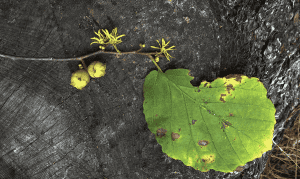The Last Flower of Fall
When walking on my favorite trail recently, I noticed the last flowers of fall blooming in profusion. The Common Witch-hazel shrubs were sporting their yellow leaves, and their surprising bursts of yellow flowers. I always seem to forget to look for them in October, and am always happily surprised to see these late blooming flowers.
The American witch-hazel is a deciduous shrub that grows along the wetlands here. It can grow quite up to 20 feet tall. It has somewhat nondescript leaves; about 3-4 “ across, round or oval with wavy edges. The shrubs carry seed capsules, which hold four black seeds. The capsules, which have been held on the branches for a year, open at about the same time as this years’ flowers emerge, and forcefully throw their seeds, giving the shrub another common name, “snapping hazel”. Witch-hazel flowers are yellow, with four long, thin, straggling petals that curl or straighten depending on the air temperature.
Native Americans discovered many used for this plant. Its leaves, bark and twigs can be distilled into a tannin-rich “water”. This witch-hazel water has been used to soothe all types of skin irritation: rashes, insect bites, pain, swelling and minor burns. As an ointment it is used to soothe sore muscles. Colonial people learned the uses of this plant from Native Americans, and in the 1800’s bottled witch hazel water for sale. It is still available at the pharmacy. I remember my grandfather swearing by it as a treatment for his poison ivy rashes. The name witch-hazel does not refer to witches, but to the old English word wiche,meaning pliable. The twigs of the witch-hazel are used for divining rods, and diviners swear by their ability to find water with them.
If you are walking in the woods in November, you may be able to see these beautiful last flowers of the fall.
Many thanks to flora and fauna reporters for October. Please send November reports by November 30, to appear in next month’s column. You can e-mail me at mariancharman@gmail.com.
October Reports
Rosemarie Koester, Providence Rd. October Report: Turkeys, bunnies, chipmunks, squirrels in the yard. Goldfinches, sparrows on the finch feeder. Blue jay and woodpeckers on the feeder. One of the woodpeckers is working on the house. Pileated woodpecker and hawk heard. Frogs heard a few of these mild nights, some flowers still blooming.
Marian/Bill Harman, Old Colony Drive. October 9, 50’s, sunny slight breeze—a perfect fall day. A walk to the meadow: not many birds singing but heard blue jays, red-bellied woodpecker, chipping of song sparrows. Joe-Pye-Weed is in full seed. I missed the pink blosoms, but its still beautiful—fluffy, grey seed heads. Blooming: white wood asters in the dry areas, purple New England aster in the wet areas. October 13, 50’s, sunny, clear, breezy. A walk to the beaver dam: five female wood ducks took off from Snake Meadow Brook with a plaintive cry—Good Bye! Still a few colorful mushrooms along the trail, yellow and pink. October 18, 50’s, cloudy. Bill put new seed in the feeders and now the birds are coming. Three titmicel 1 cardinal, 1 red-bellied woodpecker, one blue jay, one downy woodpecker, two white-breasted nuthatches, two chickadees. October 19, 60’s, overcast. A walk at Grassy Pond: Two female mergansers diving for fish in the pond, a great blue heron heard, one quiet hermit thush seen bouncing around in the shrubs at the pond’s edge—a great treat! October 23, a walk to the beaver dam. 50’s, breezy, blue sky, lovely! Heard: downy woodpecker, blue jay, chickadees, crows, white-breasted nuthatch, some late “spring” peepers calling. Nice yellow foliage of birch, some red maple in
the wetlands. Generally not a good fall for color—too warm? One low bush blueberry blooming. Lots of witch hazel blooming. I forgot to watch for them! In the back yard, I distributed some milkweed seeds given to us by a friend. Hope they “take” by spring. October 28, sunny, 70’s. At the feeder: cardinal, chickadee, two titmice
Marian Harman is a member of the Westford Conservation Trust, a non-profit conservation organization, dedicated to the preservation of Westford’s open spaces and trails. The Trust welcomes new members and volunteers. Check out our website at westfordconservationtrust.org, and visit us on Facebook

